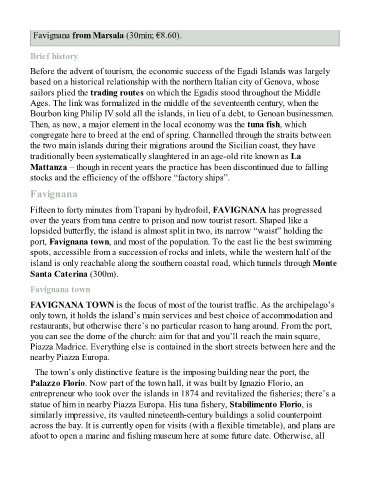Page 511 - The Rough Guide of Sicily
P. 511
Favignana from Marsala (30min; €8.60).
Brief history
Before the advent of tourism, the economic success of the Egadi Islands was largely
based on a historical relationship with the northern Italian city of Genova, whose
sailors plied the trading routes on which the Egadis stood throughout the Middle
Ages. The link was formalized in the middle of the seventeenth century, when the
Bourbon king Philip IV sold all the islands, in lieu of a debt, to Genoan businessmen.
Then, as now, a major element in the local economy was the tuna fish, which
congregate here to breed at the end of spring. Channelled through the straits between
the two main islands during their migrations around the Sicilian coast, they have
traditionally been systematically slaughtered in an age-old rite known as La
Mattanza – though in recent years the practice has been discontinued due to falling
stocks and the efficiency of the offshore “factory ships”.
Favignana
Fifteen to forty minutes from Trapani by hydrofoil, FAVIGNANA has progressed
over the years from tuna centre to prison and now tourist resort. Shaped like a
lopsided butterfly, the island is almost split in two, its narrow “waist” holding the
port, Favignana town, and most of the population. To the east lie the best swimming
spots, accessible from a succession of rocks and inlets, while the western half of the
island is only reachable along the southern coastal road, which tunnels through Monte
Santa Caterina (300m).
Favignana town
FAVIGNANA TOWN is the focus of most of the tourist traffic. As the archipelago’s
only town, it holds the island’s main services and best choice of accommodation and
restaurants, but otherwise there’s no particular reason to hang around. From the port,
you can see the dome of the church: aim for that and you’ll reach the main square,
Piazza Madrice. Everything else is contained in the short streets between here and the
nearby Piazza Europa.
The town’s only distinctive feature is the imposing building near the port, the
Palazzo Florio. Now part of the town hall, it was built by Ignazio Florio, an
entrepreneur who took over the islands in 1874 and revitalized the fisheries; there’s a
statue of him in nearby Piazza Europa. His tuna fishery, Stabilimento Florio, is
similarly impressive, its vaulted nineteenth-century buildings a solid counterpoint
across the bay. It is currently open for visits (with a flexible timetable), and plans are
afoot to open a marine and fishing museum here at some future date. Otherwise, all

